San Fernando, Buenos Aires, Argentina
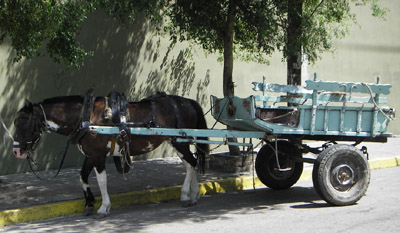 While most people either bicycle, drive or use the extensive bus and train systems, I see quite a few horses pulling carts around here also. It seems like an ingenious solution for getting stuff around in a country where there is lots of grazing land, and imported cars and parts are very expensive. The carts are made from old cars or trucks, with boards used to make the box.
While most people either bicycle, drive or use the extensive bus and train systems, I see quite a few horses pulling carts around here also. It seems like an ingenious solution for getting stuff around in a country where there is lots of grazing land, and imported cars and parts are very expensive. The carts are made from old cars or trucks, with boards used to make the box.
Monthly Archives: December 2008
Liferaft Test, Part 4
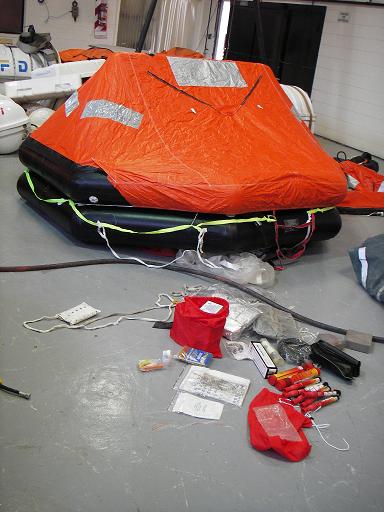 Now that the liferaft had been inflated, a check of the functionality and expiry dates of all the equipment inside (sitting in front of the raft in the picture) was done. The sun canopy has been pulled down over the liferaft in this picture. Underneath (not shown, but inspected), are pockets that hold water to keep the raft relatively stable.The flares, flashlight and batteries were out of date and replaced, and the expiry dates on all equipment were recorded in the liferaft logbook.The test is not finished at this point–a few days must pass without the raft deflating to be able to certify it. I expect to have the raft back aboard sometime next week.
Now that the liferaft had been inflated, a check of the functionality and expiry dates of all the equipment inside (sitting in front of the raft in the picture) was done. The sun canopy has been pulled down over the liferaft in this picture. Underneath (not shown, but inspected), are pockets that hold water to keep the raft relatively stable.The flares, flashlight and batteries were out of date and replaced, and the expiry dates on all equipment were recorded in the liferaft logbook.The test is not finished at this point–a few days must pass without the raft deflating to be able to certify it. I expect to have the raft back aboard sometime next week.
Liferaft Test, Part 3
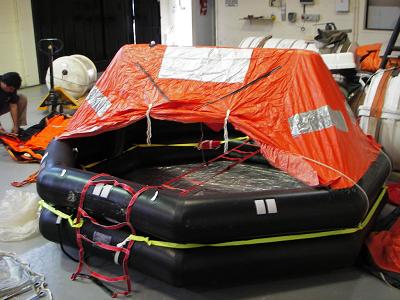 Liferafts have a bad reputation for not always inflating. I was glad to watch my raft successfully inflate, then dismayed at the continuing hiss of air out of what I thought was a manual inflation valve. The air was actually from an overpressure valve, as the CO2 cannister is apparantly larger than necessary to inflate the raft at room temperatures, so the raft vents the excess air out. After a couple of minutes, all the noise stopped, and the liferaft remained inflated.
Liferafts have a bad reputation for not always inflating. I was glad to watch my raft successfully inflate, then dismayed at the continuing hiss of air out of what I thought was a manual inflation valve. The air was actually from an overpressure valve, as the CO2 cannister is apparantly larger than necessary to inflate the raft at room temperatures, so the raft vents the excess air out. After a couple of minutes, all the noise stopped, and the liferaft remained inflated.
Liferaft Test, Part 2
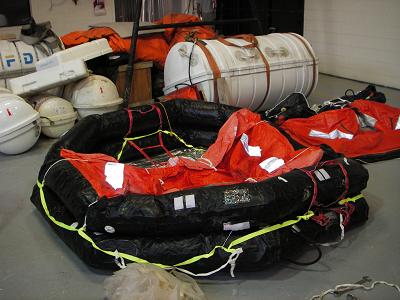 I got to do the honors of pulling the inflation cord (which causes the gas bottle to inflate the liferaft) to test that the whole system worked. With a bang and a lot of hissing, the liferaft began inflating….
I got to do the honors of pulling the inflation cord (which causes the gas bottle to inflate the liferaft) to test that the whole system worked. With a bang and a lot of hissing, the liferaft began inflating….
Liferaft Test, Part 1
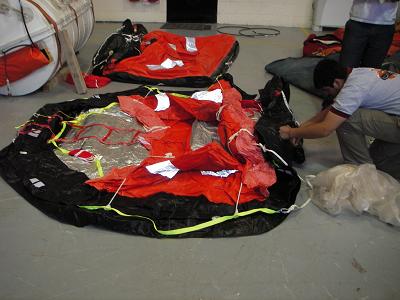 Periodically, liferafts need inspection. The period seems to vary by either manufacturer or country. Bombard, the French company which made the liferaft on Issuma, wants inspections done every three years. Argentina expects them to be done every year. By Bombard standards, it was almost time for my raft to be inspected, so I took it to a local chandlery that said they could do it. I checked Bombard’s website, and they don’t seem to have any authorized service stations in South America. I figured it wasn’t that important to have an authorized service center inspect it as long as I could be there to see the inspection done (there are horror stories of inspection stations claiming to inspect rafts but really not bothering to). The local chandlery (Costanera Uno) actually sent it off to a liferaft inspection company, IDP, located outside the center of Buenos Aires. After a few taxi rides, I went into a converted house where the inspections were done. In the picture, the liferaft has been unpacked from the plastic box (not shown) and plastic bag (on the right) that it normally lives in (the plastic bag surrounds the liferaft inside the plastic box, and keeps water out of it).
Periodically, liferafts need inspection. The period seems to vary by either manufacturer or country. Bombard, the French company which made the liferaft on Issuma, wants inspections done every three years. Argentina expects them to be done every year. By Bombard standards, it was almost time for my raft to be inspected, so I took it to a local chandlery that said they could do it. I checked Bombard’s website, and they don’t seem to have any authorized service stations in South America. I figured it wasn’t that important to have an authorized service center inspect it as long as I could be there to see the inspection done (there are horror stories of inspection stations claiming to inspect rafts but really not bothering to). The local chandlery (Costanera Uno) actually sent it off to a liferaft inspection company, IDP, located outside the center of Buenos Aires. After a few taxi rides, I went into a converted house where the inspections were done. In the picture, the liferaft has been unpacked from the plastic box (not shown) and plastic bag (on the right) that it normally lives in (the plastic bag surrounds the liferaft inside the plastic box, and keeps water out of it).
Chandleries
San Fernando, Buenos Aires, Argentina
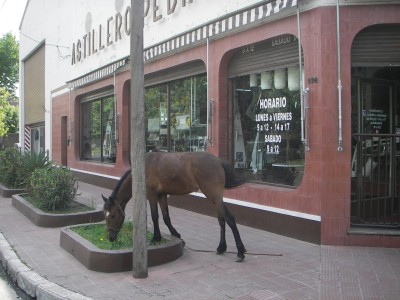 I motored Issuma upriver to San Fernando (a suburb of Buenos Aires) last week. Yacht Club Argentino was kind enough to let me use their location in San Fernando, which has haulout and repair facilities. San Fernando and the surrounding area has thousands of pleasure boats, and seems to have several fibreglass boatbuilding companies, and several chandleries (yacht equipment stores). The picture above is one of the local chandleries. I don’t think the horse eating the dandelions has anything to do with the chandlery, but it seemed to make for a nice picture.
I motored Issuma upriver to San Fernando (a suburb of Buenos Aires) last week. Yacht Club Argentino was kind enough to let me use their location in San Fernando, which has haulout and repair facilities. San Fernando and the surrounding area has thousands of pleasure boats, and seems to have several fibreglass boatbuilding companies, and several chandleries (yacht equipment stores). The picture above is one of the local chandleries. I don’t think the horse eating the dandelions has anything to do with the chandlery, but it seemed to make for a nice picture.